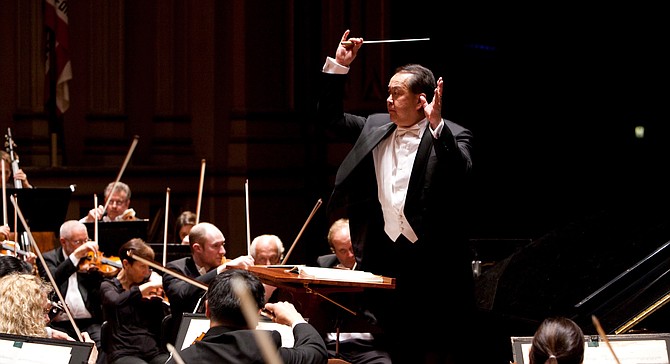 Facebook
Facebook
 X
X
 Instagram
Instagram
 TikTok
TikTok
 Youtube
Youtube

Saturday, May 27 was the second of three final concerts at the San Diego Symphony. These concerts conclude the Jacobs Masterworks Series and Maestro Jahja Ling’s tenure as music director of the orchestra.
The concert was Brahms Piano Concerto No. 2 and Sibelius Symphony No. 2. Both these composers have been integral to Maestro Ling’s vision over the past several years.
During the 2015-2016 season the San Diego Symphony presented Brahms Piano Concerto No. 1. For both the first and second concertos it’s the slow movement which governs the heart of the experience.
Pianist Yefim Bronfman plays upon the world stage, and his rendering of the third movement was worth the entire concert by itself. Would that Brahms had ended the concerto at that point instead of forcing an unorthodox fourth movement, which is far from his best and something of a letdown after the translucent third movement.
The opening movement of the Sibelius had me somewhat nonplussed. The feeling of expansive vistas opening on top of one another was obscured by some impressive dynamics.
Make no mistake — the contrast was impressive, but I felt it to be disruptive in Sibelius’s already episodic orchestration. Instead of bloom upon bloom upon bloom it felt more like polemic statements vying with each other for primacy.
Perhaps that was Maestro Ling’s intention, because the concluding movement’s “big theme” arrived as a passionate yet contrite lover atoning for previous abuses. It was full-on make-up sex.
The brass and percussion transformed from forceful and insistent into powerful and wise. The strings came undone in their outpouring of passion. The woodwinds were kind of the third person in a menage a trois.
I found the conclusion which Sibelius composed to be a fitting comment on the glorious tradition Maestro Ling and the orchestra have developed over the past 13 years.
Tutti Bravi.


Saturday, May 27 was the second of three final concerts at the San Diego Symphony. These concerts conclude the Jacobs Masterworks Series and Maestro Jahja Ling’s tenure as music director of the orchestra.
The concert was Brahms Piano Concerto No. 2 and Sibelius Symphony No. 2. Both these composers have been integral to Maestro Ling’s vision over the past several years.
During the 2015-2016 season the San Diego Symphony presented Brahms Piano Concerto No. 1. For both the first and second concertos it’s the slow movement which governs the heart of the experience.
Pianist Yefim Bronfman plays upon the world stage, and his rendering of the third movement was worth the entire concert by itself. Would that Brahms had ended the concerto at that point instead of forcing an unorthodox fourth movement, which is far from his best and something of a letdown after the translucent third movement.
The opening movement of the Sibelius had me somewhat nonplussed. The feeling of expansive vistas opening on top of one another was obscured by some impressive dynamics.
Make no mistake — the contrast was impressive, but I felt it to be disruptive in Sibelius’s already episodic orchestration. Instead of bloom upon bloom upon bloom it felt more like polemic statements vying with each other for primacy.
Perhaps that was Maestro Ling’s intention, because the concluding movement’s “big theme” arrived as a passionate yet contrite lover atoning for previous abuses. It was full-on make-up sex.
The brass and percussion transformed from forceful and insistent into powerful and wise. The strings came undone in their outpouring of passion. The woodwinds were kind of the third person in a menage a trois.
I found the conclusion which Sibelius composed to be a fitting comment on the glorious tradition Maestro Ling and the orchestra have developed over the past 13 years.
Tutti Bravi.
Comments